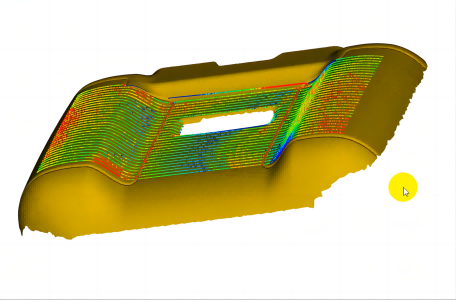Advantages of Multiple Sensor Measurement Systems for Measuring Gamepads
Multi-sensor measurement systems have significant advantages in measuring gamepads, such as high accuracy, rich data acquisition capability, and high adaptability. These advantages make the multi-sensor measurement system an ideal choice for gamepad measurement, helping to improve product quality, optimize user experience and promote the sustainable development of gamepad manufacturing.
I. High-precision measurement capability
The multi-sensor measurement system realizes high-precision measurement of gamepads by integrating data from multiple sensors (e.g., laser displacement sensors, vision cameras, etc.). Such a system is able to make full use of the advantages of various sensors and compensate for the shortcomings of a single sensor in measurement, thus improving the accuracy and reliability of measurement. For devices such as gamepads, which require precise control of inputs, high-precision measurement is a key factor in ensuring user experience and product performance.

II. Rich data accessibility
The multi-sensor measurement system not only captures the 3D shape and size data of the gamepad, but also the dynamic performance data of the joystick during use, such as the response time of the buttons and the sensitivity of the joystick. These data are crucial for comprehensively evaluating the performance and design of a joystick, and can help manufacturers more accurately understand the characteristics of a joystick and provide data support for product improvement and optimization.
III. Adaptability
Multi-sensor measurement systems are highly flexible and scalable, and can be customized and configured for different measurement needs. Both sensor types, measurement ranges and system architecture can be adjusted and expanded according to actual application scenarios. This enables the system to adapt to the measurement needs of different types and specifications of gamepads, improving measurement flexibility and efficiency.
IV. Automation and efficiency
Compared with the traditional measurement method, the multi-sensor measurement system can realize automatic measurement and reduce the interference and error of human operation. Through programming control, the system can automatically complete the steps of handle placement, scanning and data processing, which greatly improves the efficiency and accuracy of measurement. In addition, the system can output the measurement results in real time, which is convenient for users to make quick analysis and decision.

V. Non-contact measurement
Multi-sensor measurement systems usually utilize non-contact measurement, which means that there is no need for direct contact with the The measurement is usually non-contact, which means that there is no direct contact with the surface of the handle during the measurement process. This means that no direct contact with the surface of the handle is required during the measurement. This not only prevents damage or contamination of the handle, but also ensures stability and consistency of the measurement.
Product recommendation
TECHNICAL SOLUTION
MORE+You may also be interested in the following information
FREE CONSULTING SERVICE
Let’s help you to find the right solution for your project!


 ASK POMEAS
ASK POMEAS  PRICE INQUIRY
PRICE INQUIRY  REQUEST DEMO/TEST
REQUEST DEMO/TEST  FREE TRIAL UNIT
FREE TRIAL UNIT  ACCURATE SELECTION
ACCURATE SELECTION  ADDRESS
ADDRESS Tel:+ 86-0769-2266 0867
Tel:+ 86-0769-2266 0867 Fax:+ 86-0769-2266 0867
Fax:+ 86-0769-2266 0867 E-mail:marketing@pomeas.com
E-mail:marketing@pomeas.com
